Narmer Palette › Book of Amos » Ancient origins
Articles and Definitions › Contents
- Narmer Palette › Antique Origins
- Book of Amos › Antique Origins
Ancient civilizations › Historical and archaeological sites
Narmer Palette › Antique Origins
Definition and Origins
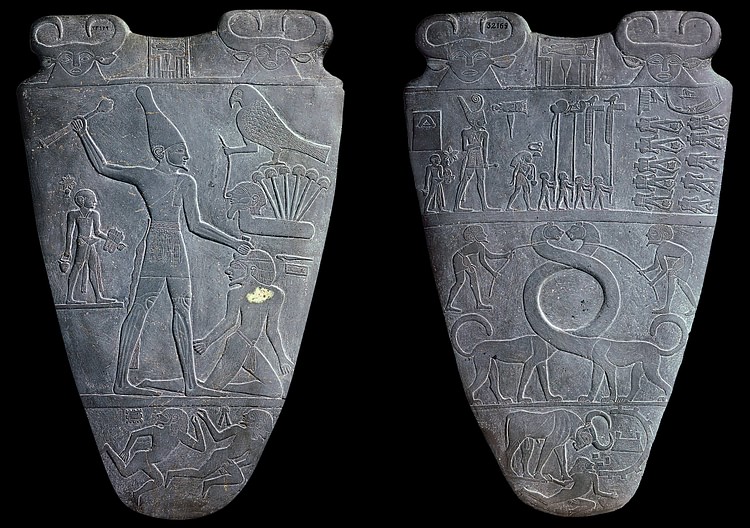
The Narmer Palette (also known as Narmer 's Victory Palette and the Great Hierakonpolis Palette) is an Egyptian ceremonial engraving, a little over two feet (64 cm) tall and shaped like a chevron shield, depicting the First Dynasty king Narmer conquering his enemies and uniting Upper and Lower Egypt. It features some of the earliest hieroglyphics found in Egypt and dates to c. 3200-3000 BCE. The palette is carved of a single piece of siltstone, commonly used for ceremonial tablets in the First Dynastic Period of Egypt. The fact that the palette is carved on both sides means that it was created for ceremonial instead of practical purposes. Palettes which were made for daily use were only decorated on one side. The Narmer Palette is intricately carved to tell the story of King Narmer's victory in battle and the approval of the gods at the unification of Egypt.
BACKGROUND OF THE PALETTE'S SCENES
The engraving depicts a victorious Egyptian king unifying the land under his rule. Traditionally, this king was known as Menes, the first king of the Early Dynastic Period who united Upper and Lower Egypt through conquest. His predecessor, according to the 3rd century BCE historian Manetho, was a king named Narmer, who sought to unify the country through peaceful means. Menes has been associated with Narmer and also with Menes' successor, Hor-Aha, who is also credited with the unification of Egypt.
Manetho's original chronology has been lost but is quoted extensively in the works of later writers. In the early days of Egyptology, Manetho's list (apart from the gods-as-kings which begin it) was taken as fact but, as more artifacts and temples were discovered, this view shifted. The claim of Menes as the first king of the First Dynasty grew increasingly hard to maintain as no archaeological record of such a king surfaced, and when the rare Menes artifact did come to light, it did not seem to designate explicitly the first king of the First Dynasty (which is why the name 'Menes' is associated with three different rulers).
Egyptologist Flinders Petrie was the first to associate Menes with Narmer and claim they were a single ruler. 'Menes', according to Flinders Petrie, was an honorary name meaning "he who endures" while Narmer was a personal name. The association of the name 'Menes' with the later ruler Hor-Aha would pose no problem in that Hor-Aha could have been given the same honorific when he was king.
NARMER WAS THE FIRST KING OF THE FIRST DYNASTY OF EGYPT AND THE NARMER PALETTE WAS MOST LIKELY CREATED TO CELEBRATE HIS MILITARY VICTORIES OVER LOWER EGYPT.
Narmer, then, was the first king of the First Dynasty of Egypt and the Narmer Palette was most likely created to celebrate his military victories over Lower Egypt. The palette clearly indicates the king of Upper Egypt conquering Lower Egypt and thus unifying the two, but modern scholarship doubts this was actually accomplished by one king. Dates for the unification of Egypt run from as early as c. 3150 BCE to as late as c. 2680 BCE. It is usually accepted that the date for unification is c. 3150 BCE at the beginning of the First Dynasty but upheavals during the Second Dynasty (c. 2890-2670 BCE) indicate that this unification did not last. Every king of the Second Dynasty had to contend with some kind of civil unrest or outright civil war and inscriptions from the time indicate the conflict was between Upper and Lower Egypt, not foreign antagonists. If Narmer did unite the two lands of Egypt he most likely did so through military conquest and, if he united the lands peacefully, would have probably had to hold it together through repeated campaigns such as the one depicted on the Narmer Palette.
DESCRIPTION
On one side, Narmer is depicted wearing the war crown of Upper Egypt and the red wicker crown of Lower Egypt which signifies that Lower Egypt fell to him in conquest. Beneath this scene is the largest engraving on the palette of two men entwining the serpentine necks of unknown beasts. These creatures have been interpreted as representing Upper and Lower Egypt but there is nothing in this section to justify that interpretation. No one has conclusively interpreted what this section means. At the bottom of this side of the palette, the king is depicted as a bull breaking through the walls of a city with his horns and trampling his enemies beneath his hooves.
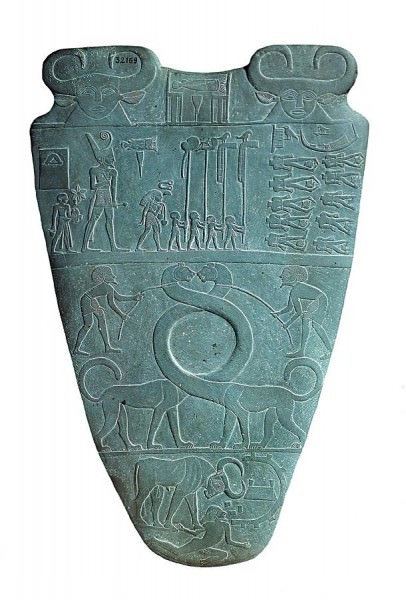
Narmer Palette
The other side of the palette (considered the back side) is a single, cohesive image of Narmer with his war club about to strike down an enemy he holds by the hair. Beneath his feet are two other men either dead or attempting to escape his wrath. A bald servant stands behind the king holding his sandals while, in front of him and above his victim, the god Horus is depicted watching over his victory and blessing it by bringing him more enemy prisoners.

Narmer
Both sides of the palette are decorated at the top with animal heads which have been interpreted as either bulls or cows.Archaeologists and scholars who claim those are the heads of cows associate the engravings with the goddess Hathor, who is regularly depicted as a woman with a cow's head, a woman with cow's ears, or simply as a cow. As Hathor is not associated with warfare or conquest, this interpretation makes no sense in context. A more sensible interpretation is that the heads represent bulls since the king is depicted elsewhere on the palette as a bull storming a city. The bull would represent the king's strength, vitality, and power.
DISCOVERY
The Narmer Palette was discovered in 1897-1898 CE by the British archaeologists Quibell and Green in the Temple of Horus at the city of Nekhen (also known as Hierakonpolis), which was one of the early capitals of the First Dynasty of Egypt. The scenes engraved on the siltstone were considered an account of an actual historical event until fairly recently when it has come to be regarded as a symbolic inscription. There are many different theories concerning the palette and, to date, there is no consensus on what the inscription means or whether it relates to historical events.
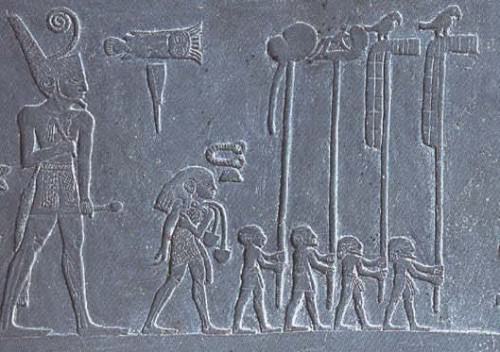
Narmer
The palette was discovered among other artifacts associated with Narmer's reign such as his mace and another mace fragment inscribed with the name of King Scorpion. Scorpion may have been one of Narmer's predecessors or could have been an adversary and rival for the throne. Quibell and Green failed to note where the palette was found in relation to the other objects and further failed to include the location where many other artifacts were discovered in their survey.
The result of their mistake in proper recording is that no one knows what the relation of the artifacts were to each other and where they were discovered in the temple. If they were together in one area it could mean they were considered sacred objects or perhaps simply valuable artifacts stored in a safe place. If they were found separately, the precise spot in the temple could shed some light on how they were regarded. If King Scorpion's mace was located in a chest and Narmer's in a place of honor (or vice versa) much might be deduced on how these pieces were regarded by the people of the time. No such notes were made, unfortunately, and the artifacts were simply removed without cataloging them. Any interpretation of the pieces found in the 1897-1898 dig at Nekhen must be speculative.
INTERPRETATION
This speculation extends to the Narmer Palette, which might depict an event from history or may simply be an honorary engraving which shows the strength and vigor of the king in battle. The evidence of civil conflict during the Second Dynasty, as noted above, indicates unification did not hold and that it was Khasekhemwy (c. 2680 BCE), last king of the Second Dynasty, who succeeded in unifying Egypt in the way Narmer is shown on the palette. Khasekhemwy has long been a strong candidate for the honor of the first king to unify the country and this claim is supported by the prosperous reign of his son, Djoser (c. 2670 BCE), who built the Step Pyramid and its surrounding complex at Saqqara.
It seems clear that Khasekhemwy did unite Egypt but evidence such as the Narmer Palette and inscriptions showing King Den (c. 2990 BCE) wearing the double crown of Upper and Lower Egypt strongly suggest Khasekhemwy was not the first. Egypt would experience a number of periods of civil strife and fracture during its long history and would be reunited and reformed over and over again. Narmer's first unification would have had to be maintained by the later kings and, according to both inscriptions and physical evidence, it was. Khasekhemwy would have been only one of a number of rulers who had to put Egypt back together again, not the first to unite the two lands. The Narmer Palette, however one interprets it, shows that unification was accomplished centuries before Khasekemwy by King Narmer.
Book of Amos › Antique Origins
Definition and Origins
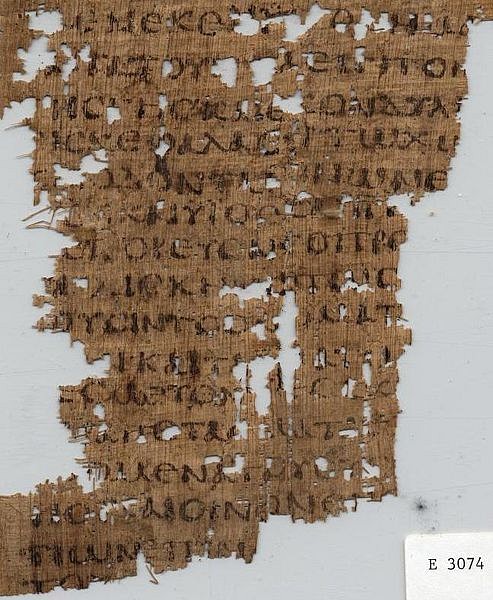
The Book of Amos is a prophetic book of the Hebrew Bible largely dating to the 8th century BCE and considered to be scripture by modern-day Jews and Christians. The work chronicles the visions that the ancient author of this book believed he received from God in order to warn Israel of its impending doom and destruction unless it restores its religious duties to God instead of engaging in the evil and sin that Amos believes has been pervading throughout his country, both in the kingdoms of Israel and in Judah. Naturally, the book also takes place in Israel, as Amos prophesies and preaches to the inhabitants of this land of the judgement of God.
DATING
The Book of Amos is considered one of the earliest biblical books by scholars, as it dates to the middle of the 8th century BCE.Amos informs us that he is writing during the reigns of Jeroboam II and Uzziah, both of whom are biblical kings known from the archaeological record to have reigned from the 8th century BCE. Secondly, Amos states that he is writing two years before a major earthquake (Amos 1.1), an earthquake that has been identified by geologists and known to have devastated Israel somewhere during the middle of the 8th century BCE. Thirdly, in the sixth chapter of Amos (Amos 6.1-2), Amos talks about the destruction of three known ancient cities. These cities are of Calneh, Hamath, and Gath, and are used by Amos to demonstrate to Israel what will happen to them if they do not obey God. The only period in which all three of these cities were destroyed around the same time is c. 900 BCE, and thus Amos was likely writing soon thereafter. According to the scholar Aren Maeir;
It would appear, therefore, that the only viable historical and geopolitical context in which the destruction of Gath, Calneh and Hamath Rabah would be mentioned together would have existed not long after the late 9th century BCE. Later, although Calneh and Hamath continued to be important cities, Gath lost its prominent role.Consequently, one should assume that this passage is to be associated with the original text of the Book of Amos, most consonant with the first half of the 8th century BCE. Attempts to date it to a later stage and to suggest alternative contexts for the reference to these three cities appear to fly in the face of the available historical, biblical, and archaeological evidence (327-328).
STRUCTURE
In the introduction of the book, the author tells us that his name is Amos, as well as that he is a sheep breeder from Tekoa.Interestingly, Tekoa remains a city of Israel to this day. The content of the Book of Amos can be divided into the following structure:
- Introduction (Amos 1.1-2)
- Oracles (1.3-2.6)
- Addressing of Female Samarians (4.1-3)
- Addressing of Rich Samarians (6.1-7)
- Addressing of Rich in Jerusalem (8.4-8)
- Symbolic Visions of Israel's Judgement and Confrontation with Amaziah (7.1-9.8a)
- Epilogue (9.8b-15).
Amos did not believe he was writing in a great time. He believed that he was living in a time of wickedness and he came to the belief that God had given him the duty of preaching to the kingdom of Israel that, if they failed to obey God's commandments and turn themselves from their evil ways, they would be judged by God.
THE MAJORITY OF MODERN SCHOLARS CONSIDER THE GENRE OF THE BOOK OF AMOS TO BE A PROPHETIC BOOK.
Thus, the majority of modern scholars consider the genre of the Book of Amos to be a prophetic book, many even believing that a specified genre that can unify the entire book and its themes to be a 'covenant enforcement document,' where Amos utilized and developed the law of Moses and its stipulations and punishments in forming the structure and form of his book.
BRIEF SUMMARY
The Book of Amos is relatively short, spanning nine chapters. It begins with a very short introduction from Amos himself, in which he names the kings reigning over Israel and Judah in his time, and he proceeds to proclaim that it was God himself who has given him the visions of which he is about to declare to Israel and Judah. After this, Amos begins telling us what his deity, Yahweh, has spoken.
At the start, Yahweh declares that he will punish cities like Damascus, Tyre, Ammon, and many others for their sins. The final two regions that Yahweh speaks against are Israel and Judah themselves, because of their lies, their failure to keep Yahweh's commandments, sexual impurity, and several other abominations that Yahweh proclaimed that they committed.Yahweh chastises Israel and Judah, for even though he had corrected and punished them many times beforehand, they refused to return to Yahweh and own up to their mistakes. Rather, they maintained their impure ways, in spite of God's warnings. Then, Yahweh tells Israel and Judah to abandon their evil ways in favor of good and to begin establishing justice in their lands. Yahweh then describes the destruction of the wicked that will occur on the day of the Lord, the day where the Lord is supposed to enter the Earth and judge it, and thereby proceeds to provide Amos with several visions of how God will bring agony and suffering to the wicked in Israel and Judah.
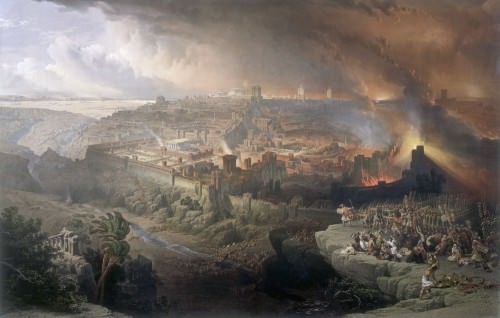
The Siege and Destruction of Jerusalem
All of a sudden, a figure by the name of Amaziah appears, supposedly a priest of Bethel, who begins telling Amos to go off and prophesy elsewhere, as long as he leaves Bethel, the place of the king's sanctuary. Amos rebukes Amaziah for this, telling him that, because he is trying to stop the prophecy directed to him by God, God will reign destruction on both him and his family. In the entire Book of Amos, Amaziah is the only person who speaks other than God's visions to Amos and Amos himself.
"You have lifted up the shrine of your king,
the pedestal of your idols,
the star of your god—
which you made for yourselves.
Therefore I will send you into exile beyond Damascus,”
says the Lord, whose name is God Almighty. (Amos 5.27-28)
After Amos finishes receiving the visions of how Israel will be annihilated, the book ends on a more promising note. After all this comes to pass, God promises to restore Israel to its old and glorious days, alluding to the time of the monarch and famous king, David.
HISTORICAL BACKGROUND
Because the Book of Amos is a prophetic book and not an ancient history, such as ones that were written by the likes of Herodotus and Thucydides, it contains little recorded history to examine as a background for its events.
WE, UNFORTUNATELY, KNOW VERY LITTLE ABOUT AMOS HIMSELF, BESIDES BEING FROM JUDEA & THAT HE IS TODAY CONSIDERED ONE OF THE MINOR PROPHETS.
Throughout the book, we are given the names of a few kings (Jeroboam, Uzziah, David), a few cities and regions (Calneh, Hamath, Ammon, Gath, Tyre, Damascus, Gaza, Edom, Tekoa, Moab, Israel, Judah, and Bethel), and one solid historical background event (the earthquake of Israel from the 8th century BCE). Besides this general information, little else can be known about the Book of Amos, besides that its author went by the name of Amos, claimed to have been a sheep breeder from Tekoa, and was apparently literate so as to be able to write this book (although he may have had a scribe to assist him, as few sheep breeders were literate at this time). We, unfortunately, know very little about Amos himself, besides being from Judea and that he is today considered one of the minor prophets of the Old Testament, and we have absolutely no idea regarding anything of his friends or family members.
Indeed, because this book was written in the prophetic genre, it is focusing on the morality of Israel and Judah and how the people of these lands need to return to God and Amos focuses on this rather than giving a detailed account of himself or the regions and events of his time, similar to other well-known prophetic writings such as, most comparably, the Book of Revelation from the New Testament. Notably, however, the Book of Amos was included in the canon of the Old Testament very early on, as is attested by its inclusion in the Dead Sea Scrolls, and it is the first ancient writing to use the phrase "day of the Lord." Less than 200 years after Amos prophesied to Israel about their destruction lest they return to God, the king of Babylon, Nebuchadnezzar II, invaded Israel, conquered Jerusalem, and exiled tens of thousands of Jewish peoples to foreign lands.
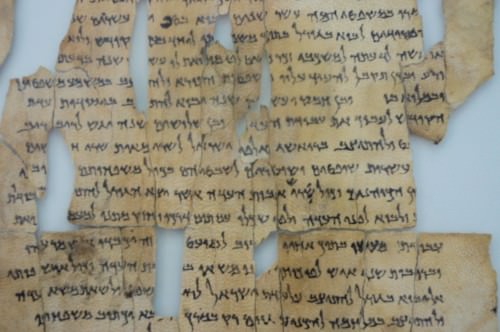
Dead Sea Scrolls
CONCLUSION
The Book of Amos is one of the oldest complete books of ancient prophetic writing, one of the books of the biblical canon, and has attracted the attention of innumerable theologians, historians, and commentators. Besides the prophetic genre, the Book of Amos has shown itself to be useful in a variety of ways, as theologians and historians have used the work to discuss and analyze the history of the composition of the biblical texts, the understanding of the minor prophetic books of the Bible, and recently, even the exodus out of Egypt itself. It is no doubt illuminating to both readers, enthusiasts and critics to see how some of the ancient Israelites like Amos regarded morality and evil and how their fellow Israelites and brethren were behaving.For these reasons, one may see there is little surprise as to why Amos became one of the most widely distributed books of its time.
LICENSE:
Article based on information obtained from these sources:with permission from the Website Ancient History Encyclopedia
Content is available under License Creative Commons: Attribution-NonCommercial-ShareAlike 3.0 Unported. CC-BY-NC-SA License